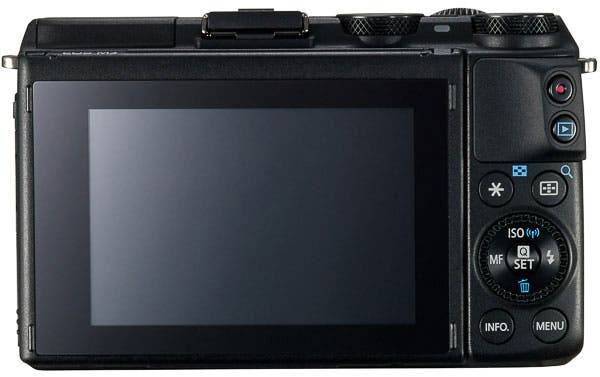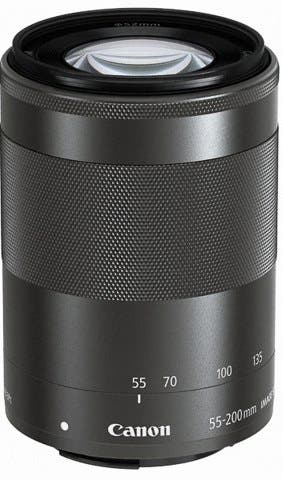August 27, 2015: Canon today announced its third and most advanced mirrorless interchangeable-lens camera, the Canon EOS M3. Boasting a new 24.2MP APS-C sensor, a new Digix 6processor, and a promise of faster performance, a wider ISO range and Wi-Fi and NFC connectivity, the M3 represents a major makeover, and big step forward for Canon into the competitive MILC market. In addition to the M3, Canon introduced three new EF-M mirrorless lenses plus a new prime lens for its DSLR line.

Canon EOS M3 Key Features:
- 24.2MP CMOS APS-C sensor
- ISO range 100-12,800, expandable to 25,600
- Digic 6 image processor
- Front dial and exposure compensation dial
- 1.04 million dot resolution, 3-inch, Flip-out touch screen
- EF-M mount; compatible with all EF and EF-S lenses via adapter
- Accepts EVF-DC1 external electronic viewfinder
- 1080p MP4 video at 24, 30p; manual movie control available
- Wi-Fi, NFC connectivity to iOS, Android smartphones and tablets
- Compatible with Canon Connect Station CS10
- Creative Assist easy setting adjustment
- 4.2fps burst rate in JPEG or RAW

Let’s take a closer look at this new camera from Canon.
Externally, Canon EOS M3 bears a striking similarity to the recently-announced Canon PowerShot G3-X—albeit without the built-in superzoom lens. There are many similarities in its control layout and features, although the M3 offers a larger, higher-resolution filter and, of course, entree into Canon’s massive family of interchangeable lenses. Unlike its immediate predecessor, the short-lived EOS M2, which was itself a minor tweak of the original EOS M, the M3 offers significant upgrades in many key areas, from the sensor and image processor to the addition of wireless communication, to its overall physical appearance; Canon has apparently given it a makeover.
The Canon M3 maintains its small dimensions and light (11.3 oz) weight, making it a tempting option for travel photographers. It also is compatible with an external EVF, which could be helpful for shooting in both bright sunlight and in low light. The camera retains the same effective 3-inch touchscreen LCD monitor and video capabilities, as well as its predecessor’s ability to capture 14-bit RAW and JPEG images.

Sensor and Processor Upgrades
The Canon EOS M3 packs a new high-resolution 24.2MP APS-C sensor, comparable to its highest resolution APS sensor DSLRs; it’s enough resolution for poster-sized prints, even with some cropping. It is backed by a DIGIC 6 image processor, which Canon says will speed up camera operations and reduce noise at higher ISO settings. It also allows for improved movie image quality at several different compressions. Face detection and image stabilization are also said to have been improved.
Canon says it has mashed up several AF technologies, with AF coverage over 80% of the vertical and 70% of the horizontal image, and a combination of phase difference and contrast detection for both low-light and low-contrast autofocus. The camera is capable of up to 4.2fps burst rate, even when shooting RAW files. Canon claims a shutter lag of 0.07 seconds.
Expanded Creative Options
The Canon EOS M3 lets you adjust background blur, color quality, contrast and apply several filter effects, and these can be done in a way that is easy for novices to understand. Creative filters include High Dynamic Range, Fish-Eye Effect, Art Bold, Water Painting, Toy Camera, Grainy B&W, and more. The camera stores up to six personal settings that can be applied when composing new images. You can also import images from other cameras into the M3 and then view the settings so you can apply them to the scenes you’re shooting.

New Control Setup
The control layout includes a new Front Dial, within quick reach of the thumb grip, and an exposure compensation dial atop the camera, as well as extensive customizable functions and user-programmable shortcuts. The touch-sensitive 3-inch LCD monitor tilts up 180 degrees, so it faces forward for selfies, and down 45 degrees for high-angle shots. The on-screen controls let you select exposure and other parameters with your left hand without needing to take your finger off the shutter release.
System Compatibility
The EOS M3 is compatible with all EOS M lenses (which are designed for the M line of mirrorless cameras) and with over 70 Canon EF and EF-S lenses, via the Mount Adapter EF-EOS M. It also has a hot shoe that accepts all Canon Speedlite flashes, as well as Speedlite Transmitters and Macro Ring Lites. An optional viewfinder, the EVF-DC1, has a high-resolution 2.36MP sensor and can tilt up to 90 degrees. Finally, videographers can use an external mic via an external microphone jack.
Make Movies
The Canon EOS M3 boasts full 1080p HD video in 24p and 30p frame rates, and can record MP4 format video. In addition to touch AF during filming, the camera offers manual exposure control via the camera’s thumb wheel and front dial.

While the original Canon EOS M and the M2 were welcomed by tepid reviews, the Canon EOS M3 is a major upgrade and indicates that Canon has gotten serious about mirrorless photography. The Canon EOS M3 will be available body only at Adorama for $679, with the 18-55mm kit lens for $799, and with the 18-55 and 55-200mm lenses as a kit for $1,049.
Four New Lenses
In addition to the M3, Canon introduced four new lenses: the EF 35mm f/1.4II USM, EF-M 11-22mm f/4-5.6 IS STM, EF-M 55-200mm f/4.5-6.3 IS STM, and EF-M 22mm f/2 STM (SL) lenses. The three new EF-M lenses join the existing kit lens, expanding the optical range of the M-series cameras.

Canon EF 35mm f/1.4II USM
Adorama Price:
The long-awaited second generation version of Canon’s large-aperture, modest wide-angle lens, the Canon EF 35mm f/1.4L II USM is the world’s first to use an exclusive Canon technology, Blue Refractive Optics (BR Optics for short). BR Optics uses an organic optical material with what Canon describes as “unique anomalous dispersion characteristics.” The molecular design refracts blue (short wavelength spectrum) light more effectively than UD, Super UD, or Fluorite, and is said to control color fringing more effectively.
Additionally, the lens has been toughened up, and is protected against dust and water. It consists of 14 elements in 11 groups, and also uses SWC (sub-wavelength structure coating) on the rear surfaces of the first and second aspheric elements to reduce flare and ghosting. The lens focuses to approximately 11 inches, closest in its class. Full-time mechanical (not wire) manual focusing is available even when the lens is set in AF mode.

Canon EF-M 11-22mm f/4-5.6 IS STM
Adorama Price:
With a 35mm equivalent coverage of a 17-35mm lens, the EF is designed for both still and HD video capture thanks to its quiet-operating STM motor, and has built-in Dynamic IS image stabilization. Inside are two aspheric and one UD lens elements, a circular 7-blade aperture, and a rear focus system. The lens retracts for easy travel. It focuses to approximately 6 inches, accommodates 55mm filters, and measures 2.4 inches in length. It weighs 7.8 oz.

Canon EF-M 55-200mm f/4.5-6.3 IS STM
Adorama Price:
Designed for portrait, wildlife and travel photography, the compact 55-200mm provides a 35mm equivalent angle of coverage of approximately 85-300mm. It packs an optical stabilizer that Canon says is effective to 3.5 stops, includes one aspheric and one UD lens element, AF and full-time manual focus, and a circular 7-blade aperture for good Bokeh. The lens focuses to 3.3 feet, accepts 52mm filters, is 3.4 inches long and weighs 9.2 oz.

Canon EF-M 22mm f/2 STM (SL)
Adorama Price:
The Pancake 22mm f/2 is a quick little go-anywhere lens designed to deliver excellent low-light performance. A quiet STM (stepping motor) is designed for optimal video autofocus, and a circular 7-inch blade will produce good Bokeh. The lens focuses down to 5.9 inches, and an aspheric lens element should provide high-quality images. The lens accepts 43mm filters, weighs just 3.7 oz, and is just under 1 inch long.






